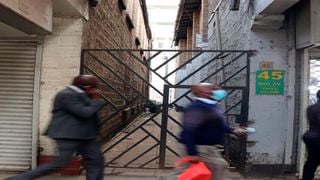
A closed Meza Lane between Moi Avenue and Kimathi Lane on June 21, 2021.
| Dennis Onsongo | Nation Media GroupNairobi
Premium
How landlords in Nairobi CBD have encroached on public alleys
In the wild we have endangered species, but in Nairobi’s central business district (CBD) lanes are in danger of disappearing.
From Kimathi Street and Moi Avenue to Standard Street, passageways that once straddled the capital’s city centre, joining different streets, are being blocked at an alarming rate.
The streets are threatened by large businesses and small-scale traders such as hawkers and shoe shiners who have taken over the footpaths.
Some of the signage for the lanes have also been conveniently brought down, erasing any memory of them and masking the ongoing impunity.
But even amid the wanton impunity, the silence from authorities at City Hall and Nairobi Metropolitan Services (NMS) is deafening.

A closed Jumba lane between Moi Avenue and Kimathi Lane on June 19, 2021. Some of the signage for the closed lanes have also been conveniently brought down, erasing any memory of them and masking the ongoing impunity.
Lanes blocked
Business owners have blocked several lanes across the city centre, with some even erecting gates and closed-circuit television (CCTV) cameras to control and monitor movement across the pathways.
Just behind Nation Centre, several lanes intersecting with Kimathi Lane are now controlled by businesses.
Meza Lane, Jumba Lane and Dodo Lane are literally under lock and key. Meza Lane has been in such condition for ages, with its rusty gate a sign of an ageing vestigial lane.
Jumba and Dodo lanes just recently got on the infamous list after Digital Shopping Mall – a business complex dealing in stalls – set up business at the building hugging the two lanes.
The two lanes have been spruced up, freshly painted and fixed with nice floor tiles with gates on both ends manned by CCTV cameras.
They are locked when dusk approaches only to be opened the following day with Dodo Lane, the only one usually open.
Just a few metres from Jumba Lane is another lane that is partially used by shoe shiners. The lane’s signage is no longer there. Across the lane is Tausi Lane just next to Nation Centre. It has also been invaded by shoe shiners.
The invasion of the lanes by shoe shiners is now a normal occurrence and part of life, with the same image replaying along Safi Lane, a lane (its signage has been vandalised) next to Café Deli on Moi Avenue, Almas Lane and Le Lan Lane.

A shoe shiner along Safi Lane in Nairobi’s CBD on June 21, 2021.
Annexed by shoe shiners
Along Standard Street, there is only a single surviving lane, which interestingly has also been annexed by shoe shiners.
Soko Lane along Banda Close is literally a soko (market), with hawkers and shoe shiners all over.
Darae Lane is now a pathway through Sonalux House on Moi Avenue. A few metres is Raa Lane. But what remains of this lane is the signage. Across is an imposing waiting area for Transchem Labaratories customers.
But there is more. Along Kigali Road, all the lanes there – Tubman, Kigali and Babar – pass through an imposing business complex bestriding the road.
On Biashara Street, Njia Lane still exists. However, it is always an enclave of street families. Next to it is Mugutila Lane – old and weather-beaten, the lane is chocking with mounds of fecal matter.
Most pathways on the street are watched over by security guards hired by the owners of businesses in the buildings.

Dodo Lane between Moi Avenue and Kimathi Lane. It is one of the public lanes closed by business people in Nairobi.
Only enough for a rat
On the other side, sits Panya Lane. Just as its name suggests, it has been blocked with the only space remaining only small enough to allow a rat through.
When reached for comment on the fast-disappearing lanes, NMS Transport, Roads and Public Works Director Michael Ochieng termed the development an illegality, saying no one is allowed to use a lane for business.
He made it clear that lanes are supposed to be used for their specific purposes as they are not business places.
“We have enhanced our enforcement team with 3,000 more officers and they will surely remove those illegally encroaching on the lanes,” he said.

A closed lane between IBEA building and Tembo Coop House in Nairob on June 21, 2021.
Out of bounds
Of all the lanes, none stands out like Watalii Lane, next to the five-star Hilton Hotel. The lane, although a public road, is out of bounds for any Tom, Dick and Harry and is only used by a select few.
But according to NMS, Hilton Hotel was given special permission by City Hall to barricade the lane around 2010 as a precaution when Kenya suffered a series of terrorist attacks at different sites in the capital city.
This was to control usage of the lane, and just like that, the lane became a restricted road used only by VIPs, the hotel’s customers and a select few who must justify why they want to use the lane.
In March, Mr Ochieng told Nation.Africa that the Watalii Lane exception for Hilton was granted on security grounds because the lane was rarely used by public service vehicles.
This is because the lane passes so close to the hotel that it offers easy and close access to the hotel, increasing its vulnerability to attacks if movements on it are not controlled.





